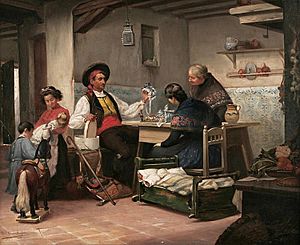Tomás García Sampedro facts for kids
Tomás García Sampedro was a Spanish painter born on May 17, 1860. He is famous for his beautiful paintings of landscapes and country scenes. His style is called costumbrista, which means he liked to show the everyday life and customs of people, especially in rural areas. He passed away in 1937.
Contents
Early Life and Education
Tomás García Sampedro was born in Pravia, a small town in Spain. His family worked on a farm. He first went to a religious school in his hometown. Later, he continued his studies at a private school in Oviedo.
In 1876, Tomás moved to Santiago de Compostela. There, he studied pharmacology, which is the science of making medicines. He finished his studies and received his license to work in 1880.
Becoming an Artist
In 1880, the same year he finished his pharmacology studies, Tomás García Sampedro published his first drawings. These drawings appeared in a magazine called La Ilustración Gallega y Asturiana. After this, he decided to move to Madrid, the capital of Spain.
In Madrid, Tomás started to focus on his art. He joined a special art school called the "Escuela Especial de Pintura, Escultura y Grabado." He also spent a lot of time at the Museo del Prado, a very famous art museum. There, he could study the works of great artists.
Tomás also joined an art club called the Círculo de Bellas Artes. Here, he met many other artists. He became good friends with Casto Plasencia, who was one of the club's founders. Plasencia became a very important teacher and guide for Tomás.
The Muros Art Colony
In the summer of 1884, Tomás invited his friend Casto Plasencia and other artists from the art club to visit his family's farm. This visit led to the creation of something special called the "Colonia artística de Muros."
This "art colony" was a group of artists who met every summer. They would paint together in the beautiful countryside. Besides Plasencia, the first members included Alfredo Perea, Tomás Campuzano, and José Robles Martínez.
The group continued to meet for six years. Sadly, Casto Plasencia died suddenly in May 1890. Even after his death, the place where they painted became famous. Other well-known artists, like Joaquín Sorolla and Cecilio Plá, continued to visit and paint there.
Studies Abroad and Awards
In 1886, Tomás García Sampedro received money from the government in Oviedo. This money, called a stipend, helped him study art in Rome, Italy. He painted a lot while he was there.
His paintings received good reviews, so the government continued to give him money. This allowed him to travel around Italy and France. He still spent his summers back home with his art group.
In 1889, while in Rome, he painted a famous work called "At the Fall of Evening." This painting won a medal at a big art show in Spain in 1890. The Spanish government bought the painting, and today you can see it at the Museo del Prado.
Later Life and Recognition
By 1892, Tomás was not feeling well and had run out of money. He returned to his home village. However, he still traveled often, visiting cities like Madrid, Barcelona, and Paris for long periods.
In 1897, one of his paintings, The Banks of the Nalón, was shown at a national art exhibition. This painting earned him a special award from the King, making him a Knight in the Order of Charles III. He also painted a portrait of King Alfonso XIII when the King was a child. This portrait was for a Spanish club in Cuba.
In 1899, Tomás painted The Asturian Reaper. This painting won a silver medal at an exhibition in Gijón in 1905. In the same year, he became an honorary member of the Academia de San Fernando, a famous art academy.
Tomás García Sampedro died in 1937 at the age of seventy-seven. He passed away in his home and studio in Muros de Nalón.
See also
 In Spanish: Tomás García Sampedro para niños
In Spanish: Tomás García Sampedro para niños



